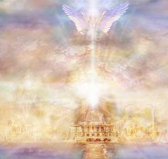
In response to yesterday's blog, I received the following question:
To what extent does Daniel 7:9 and 13, play a role in the display and picturing of "the Ancient of Days" in churches and cathedrals? Are these texts from Daniel not the justification for these presentations?
A good question and a great opportunity for a few clarifying comments.
The common translation of Daniel 7, undoubtedly has played a major role in the display and picturing of the traditional images. But before I will comment on the issue of the "Ancient of Days" in Daniel 7, I first want to emphasize that there is a enormous difference between an image that God presents of Himself and an image of God that is made by man. That is what the previous blog was all about. Man is not to make an image of God for the very reason that GOD provides an image of Himself. With respect to this, I first of all, of course, think of the Son of God, Who indeed is "the image of the invisible God" (Col.1:15). But also, more in general, when God, in visions, confronts man with Himself. These are images that come from Above.
But now, as yet, something about "the Ancient of Days", which is mentioned in almost all translations of Dan.7:9,13 and 22. The Concordant Version translates: "Transferrer of Days", which is "Mover of days." How is that to be understood? The Aramaic word, here, (ATIQ, Str. # 6268) occurs only in Daniel 7. The stem of this word conveys the primary idea of moving, in itself. In Gen.12:8: "and he moved from there" or in Job 9:5: "He removes mountains…" (See also: Job 14:8 and 18:4). With this meaning in focus, the translation, "Transferrer of days" in Daniel 7, becomes remarkably clear. Because what does the "Transferrer of days" do? He makes that the period (read: the day) of the dominion of the four beasts will come to a close (removes them) and makes room for "the day of the Son of man" (Luke 17:24). So the title "Transferrer of days" perfectly matches the function He performs in Daniel 7!
Perhaps the rendering of "the Ancient of Days" is partly inspired by the notion that his hair is "white like wool". But that is, according to me, a misunderstanding: "white" is not for old-age, but for innocence. The Aramaic word for "white", itself is derived from it (Str. #5352). Besides, even concerning the Son of Man, in Revelation 1:14, we read that "His head and hair are white like wool." In this verse, "old-age" is, in any case, not the thought; the "white" serves to accentuate cleanliness and purity.
———————————
Translation: Peter Feddema

